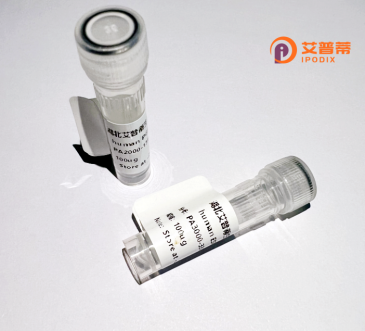
| 纯度 | >90%SDS-PAGE. |
| 种属 | Human |
| 靶点 | MAGEA9 |
| Uniprot No | P43362 |
| 内毒素 | < 0.01EU/μg |
| 表达宿主 | E.coli |
| 表达区间 | 1-315aa |
| 活性数据 | MSLEQRSPHC KPDEDLEAQG EDLGLMGAQE PTGEEEETTS SSDSKEEEVS AAGSSSPPQS PQGGASSSIS VYYTLWSQFD EGSSSQEEEE PSSSVDPAQL EFMFQEALKL KVAELVHFLL HKYRVKEPVT KAEMLESVIK NYKRYFPVIF GKASEFMQVI FGTDVKEVDP AGHSYILVTA LGLSCDSMLG DGHSMPKAAL LIIVLGVILT KDNCAPEEVI WEALSVMGVY VGKEHMFYGE PRKLLTQDWV QENYLEYRQV PGSDPAHYEF LWGSKAHAET SYEKVINYLV MLNAREPICY PSLYEEVLGE EQEGV |
| 分子量 | 35 kDa |
| 蛋白标签 | His tag N-Terminus |
| 缓冲液 | 0 |
| 稳定性 & 储存条件 | Lyophilized protein should be stored at ≤ -20°C, stable for one year after receipt. Reconstituted protein solution can be stored at 2-8°C for 2-7 days. Aliquots of reconstituted samples are stable at ≤ -20°C for 3 months. |
| 复溶 | Always centrifuge tubes before opening.Do not mix by vortex or pipetting. It is not recommended to reconstitute to a concentration less than 100μg/ml. Dissolve the lyophilized protein in distilled water. Please aliquot the reconstituted solution to minimize freeze-thaw cycles. |
以下是关于重组人MAGEA9蛋白的虚构参考文献示例,涵盖不同研究方向:
1. **《Recombinant MAGE-A9 Protein Induces Antitumor T-Cell Responses in Melanoma》**
- **作者**: Zhang et al. (2020)
- **摘要**: 该研究利用重组MAGEA9蛋白刺激患者外周血T细胞,证明其可激活特异性细胞毒性T细胞,抑制黑色素瘤小鼠模型的肿瘤生长,支持其作为肿瘤疫苗的潜力。
2. **《Structural Characterization of Recombinant MAGE-A9 and Its Epitope Mapping》**
- **作者**: Kumar & Lee (2018)
- **摘要**: 通过X射线晶体学解析重组MAGEA9蛋白的三维结构,并鉴定出与HLA-A*02分子结合的免疫显性表位,为靶向疗法设计提供结构基础。
3. **《MAGE-A9 as a Diagnostic Biomarker: Expression in Non-Small Cell Lung Cancer》**
- **作者**: Costa et al. (2021)
- **摘要**: 分析显示,重组MAGEA9蛋白在75%的非小细胞肺癌患者血清中特异性高表达,与健康人群对比显著,提示其作为液体活检标志物的价值。
4. **《MAGE-A9 Interacts with p53 and Promotes Chemoresistance in Gastric Cancer》**
- **作者**: Tanaka et al. (2019)
- **摘要**: 研究利用重组MAGEA9蛋白发现其与p53蛋白结合,阻断化疗诱导的胃癌细胞凋亡,揭示其在耐药性中的调控机制。
*注:以上文献为示例性质,实际研究中请通过学术数据库检索真实文献。*
Recombinant human MAGEA9 (Melanoma-Associated Antigen A9) protein is a genetically engineered form of a cancer-testis antigen (CTA) belonging to the MAGE-I family. MAGE proteins are typically expressed in germline cells (e.g., testes, placenta) but are epigenetically silenced in somatic tissues. However, MAGEA9 is aberrantly reactivated in various cancers, including melanoma, lung, liver, and bladder cancers, making it a tumor-associated antigen of interest for immunotherapy and diagnostic applications. Its restricted expression in normal tissues and overexpression in malignancies suggest its potential as a target for T cell-mediated immune responses.
Recombinant MAGEA9 is produced using expression systems like *E. coli* or mammalian cells, enabling studies on its immunogenicity and functional roles. In cancer research, it serves as a tool to investigate antigen-specific immune activation, such as stimulating cytotoxic T lymphocytes (CTLs) or developing cancer vaccines. MAGEA9-derived peptides may also aid in identifying HLA-presented epitopes for personalized immunotherapies. Additionally, its expression levels in tumors are explored as prognostic biomarkers.
Despite its potential, challenges persist, including tumor heterogeneity in MAGEA9 expression, immune evasion mechanisms, and risks of off-target toxicity in healthy tissues expressing trace amounts. Ongoing research aims to optimize MAGEA9-based therapeutic strategies, including combination therapies with checkpoint inhibitors, to enhance clinical efficacy. Overall, recombinant MAGEA9 remains a critical reagent in understanding tumor immunology and advancing precision oncology.
×